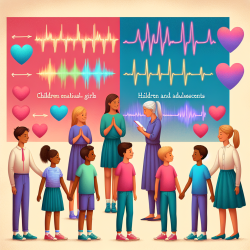Introduction
In the field of speech-language pathology, understanding the physiological underpinnings of mental health conditions can significantly enhance therapeutic outcomes. A recent meta-analysis titled "A Meta-Analysis on Sex Differences in Resting-State Vagal Activity in Children and Adolescents" provides valuable insights into how vagal activity differs between boys and girls and its implications for mental health. This blog aims to explore these findings and discuss their relevance to practitioners working with children and adolescents.
Key Findings from the Meta-Analysis
The study analyzed data from over 5,000 children and adolescents, revealing that girls generally exhibit lower vagal activity and higher mean heart rates compared to boys. This difference in vagal activity may predispose girls to a higher risk of developing internalizing disorders, such as anxiety and depression, which are more prevalent among females during adolescence.
Vagal activity, indexed by high-frequency heart rate variability (HF-HRV), is a measure of the autonomic nervous system's parasympathetic branch. Lower HF-HRV has been linked to various mental health conditions, including depression and anxiety. The study's findings suggest that these physiological differences could contribute to the sex differences observed in the prevalence of these disorders.
Implications for Practitioners
Understanding these physiological differences is crucial for practitioners. Here are some ways to apply this knowledge:
- Early Identification: Practitioners can use this information to identify children at risk of developing internalizing disorders. Monitoring HF-HRV could become a part of routine assessments for children, especially girls, to detect early signs of potential mental health issues.
- Tailored Interventions: Interventions can be tailored to address the specific needs of children based on their vagal activity levels. For instance, biofeedback and relaxation techniques that enhance vagal activity could be more emphasized in therapeutic settings for girls.
- Further Research: Encouraging further research into the mechanisms behind these sex differences can lead to more effective interventions. Understanding how factors like puberty and physical activity influence vagal activity can provide deeper insights into personalized treatment approaches.
Encouraging Further Research
While the meta-analysis provides a comprehensive overview, it also highlights the need for longitudinal studies to explore how these physiological differences evolve with age and their long-term impact on mental health. Practitioners are encouraged to collaborate with researchers to contribute to this growing body of knowledge.
Conclusion
The findings from the meta-analysis underscore the importance of considering physiological differences in vagal activity when assessing and treating mental health conditions in children and adolescents. By integrating these insights into practice, speech-language pathologists can enhance their therapeutic strategies and contribute to better mental health outcomes for children.
To read the original research paper, please follow this link: A Meta-Analysis on Sex Differences in Resting-State Vagal Activity in Children and Adolescents.










